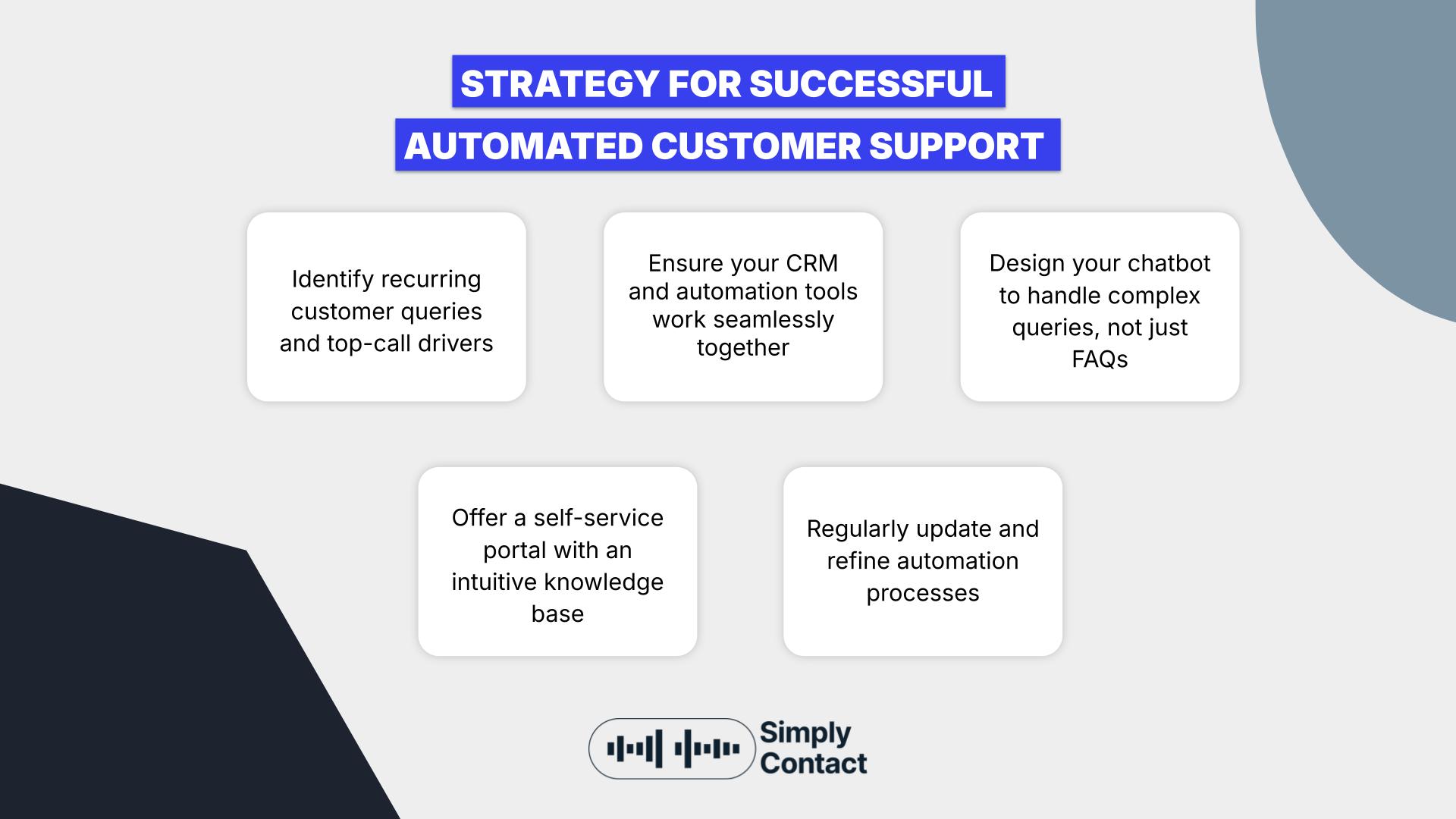At Simply Contact, we help you automate your customer service with AI-powered solutions that enhance efficiency and improve customer satisfaction. Let us guide you in creating seamless automation that frees up your team and drives business growth.

According to surveys, 67% of executives believe that artificial intelligence improves customer services via automated, personalized support. 30% of global IT professionals have already noticed how much AI saves time and resources through automation. We at Simply Contact see customer support automation as an effective solution to streamlining customer services and reaching high customer satisfaction.
As the AI call center and outsourcing customer support provider, we use the most up-to-date technologies to speed up our work. Read our comprehensive guide to the world of automation to learn more about its advantages, challenges, implementation strategies, and much more.
Ready to step into the world of automation? Request a quote to explore the best AI-powered tools.
Request a quote
What is customer service automation (CSA)?
The traditional approach to customer service was heavily connected with manual work. Teams of human agents were meant to handle all the calls during the day, answer chats, and respond to thousands of emails, spending a bunch of time without covering all the cases.
CSA implements cutting-edge technologies that simplify agents' work, enhance support capabilities, and offer customers automated round-the-clock service. Chatbots, interactive response systems, and CRMs have entirely transformed the customer support industry, making workflows more productive and time-saving. They can provide the support team with basic assistance and redirect requests in complex cases.
So, what is automated customer service? It is a tandem of state-of-the-art technology solutions and a customer support team experienced in working with them. It offers an effective combination of automated tools that empower the team, speed up ticket processing, and optimize complex workflow for higher productivity.
Why is customer support automation crucial to stay competitive?
Static shows that 73% of customers would prefer to work with your competitor if they face several bad experiences with the company. For more than half of customers, excellent service means more than the price. Such an attitude demonstrates the importance of quick, helpful, and customer-oriented reactions to queries.
If, for human agents, it's physically impossible to assist multiple customers at the same time, automated solutions can process several requests simultaneously. Self-service options will allow customers to get help with basic issues and information without human intervention and without long waiting times. As a result, your customer service will be more available and helpful, offering customers an outstanding experience and valuable advice.
The most common challenges with customer support automation

A Sun Tzu quote popular among business people says that every battle is won before it is ever fought—ancient wisdom advises to act preemptively. We invite you to review the list of the most common challenges businesses face when adopting automation solutions so you avoid some common problems in the future.
Over-reliance on automated support
If, in some cases, automated responses can easily help, in others, customers may require direct human attention. When you over-rely on automated solutions, your customers may get trapped when they are stuck with artificial intelligence and can't reach human agents when needed. As a result, you will get more frustrated customers and unresolved cases.
The solution is to ensure customers have a clear and straightforward way to reach a human agent for complex cases. It can be achieved via a prominent button in the chat menu or with the help of specific word triggers that will be a sign to transfer the request to a team of human agents automatically.
Necessity to repeat
We aim to solve the issues within the first contact, but in some cases, the request requires the assistance of another specialist or a transfer from a virtual assistant to a human one. If systems are poorly connected, the customers may have to repeat themselves each time their request is transferred across different channels. It raises frustration and reduces efficiency and overall customer satisfaction.
When the request is transferred, the agent will also get the full context of the previous conversation and assist without the need for a repeat. You can achieve such an effect with omnichannel support platforms unifying communication across chats, emails, phones, and social media.
Poor integration with other tools and platforms
The lack of seamless integration can cause disruptions in workflows. As a result, both customers and staff will experience delays and miscommunication. Support teams will not be able to react in time, and frustrated customers may leave the conversation before they can get help.
Give preference to solutions that can be smoothly integrated with CRM, ticketing, and knowledge bases. Connection with the help of APIs is more stable and can ensure streamlined workflow within various channels and platforms.
Lack of regular updates
Up-to-date information is vital for customer service and support automation, as wrong data can lead to incorrect responses. Artificial intelligence will not address customers' needs correctly, and the solutions will become ineffective. Human teams using outdated knowledge bases can also provide false information, causing customer dissatisfaction.
We recommend analyzing customer interactions regularly to detect and identify possible gaps in automated responses. Keep chatbot scripts, knowledge bases, and AI models up-to-date to ensure all responses are relevant and correct.
Misaligning automation with customer needs
The lack of empathy from AI's side and rigid automation cause an impersonal and frustrating experience for the customer.
Collect customers' feedback and fine-tune your automation solutions. Empower virtual assistance with sentiment analysis to make automated responses more empathic and aligned with user expectations. For example, 68% of customers trust AI agents with human-like traits as they are more likely to anticipate their needs.
The advantages of automated customer support

Automated solutions for customer support can enhance workflows in many ways, but we are going to review the most important of them and share a few ideas on how exactly they help.
Reduces operational costs by increasing efficiency
Automated solutions can handle all repeated and routine inquiries. This means they will cover many requests and reduce the need for a large support team. As a result, you will get lower labor costs and better response times.
Delivers round-the-clock support for customers
Human workers are limited to working hours, but chatbots and AI-powered virtual assistants can provide round-the-clock service. Customers will be able to get help regardless of part of the day, time zones, or holidays.
Centralizes and organizes customer data effectively
Automated solutions can collect, categorize, and store information about customers' interactions, feedback, previous requests, and issues. It will help you to track problems, personalize responses, and improve the overall quality of services.
Minimizes mistakes caused by human error
Automated support excludes common errors related to human factors, like typos and mistakes in data. It simplifies data entry and ticket handling. As a result, customers get more accurate and consistent service with a minimum chance of errors.
Improves scalability during peak demand periods
AI-powered systems can quickly adapt to different volumes of requests. Thanks to their ability to simultaneously process considerable data amounts, they can reduce waiting times and exclude possible service disruptions during overloaded periods.
What is included in automated customer support?
Now that you know how an automated approach to customer support can help, let's review how we can achieve all the abovementioned advantages.
AI-powered virtual assistants (chatbots)
According to the statistics, 74% of customers prefer to use chatbots when they need to get an answer to a basic question. The reason is simple: virtual assistants like ChatGPT can respond to common queries in round-the-clock mode, giving access to relevant information. Frequently asked questions will be easily covered, giving your team more time to deal with complex issues.
Chatbots can also enable information support for your human team, providing quick access to the data from your knowledge base. Instant reaction to requests allows for avoiding long waiting times and applying self-service within a few seconds instead of holding in line. Natural language processing capabilities of AI make communication human-like and highly personalized, creating a comfortable environment for customers and staff.
Interactive voice response (IVR) systems
An interactive voice response system is a self-service solution that can significantly save time for customers and agents by giving relevant information in phone call mode. Such a system can handle basic customer requirements without human intervention and enable agents' assistance only when it is required. Integrated voice menus can also help to direct customers to the right departments and specialists, reducing the number of call transfers.
Automated ticket routing and prioritization
Similar to the principles of IVRs, automated solutions for ticket routing direct requests to available specialists who will most likely help customers with their problems. The response time is significantly reduced when the right team gets the request straight away. Artificial intelligence can categorize tickets according to their subject and urgency, applying sentiment analysis to prioritize more urgent matters.
Workflow automation tools
Approximately 80% of businesses use automation to speed up processes, and 50% plan it for the future. At Simply Contact, we also consider automation a must-have when organizing highly effective and productive workflows by reducing the manual workload. Automation tools enable smooth coordination between teams and provide relevant follow-ups and notifications to keep the team informed.
Centralized knowledge bases
A knowledge base is an invaluable tool that stores all the FAQs, company guides, tips for troubleshooting, and other self-service options. It serves both agents and customers, giving instant access to all product information available through your system (e.g., a chatbot). They can also help during staff training, especially new members.
Automated email responses
You can use automated responses to keep a connection with the customers, creating the impression of constant assistance at every step of your interaction. Automated AI-powered systems can send instant replies to customer inquiries by responding to them or letting them know when they will be contacted. Automated responses may contain personalized order updates, confirmations, and follow-ups to give up-to-date information.
CRM integration
CRM systems help to synchronize customer data across multiple platforms, ensuring all your human teams and virtual assistants are on the same page. CRM keeps information about interaction history, previous issues, purchases, and many more to offer customers more personalized service and a data-driven approach.
Strategy for successful automated customer support

Strategy is a key to efficient automation, so here are a few vital tips on how to implement your automated solution most efficiently:
Identify recurring customer queries and top-call drivers
Analyze customer interactions to see what causes the most pain; prioritize it. Apply analytics to study the most frequent issues across all your support channels, use automation to cover repetitive queries, and let your human teams focus on more complex situations.
Ensure your CRM and automation tools work seamlessly together
Connecting chatbots, IVRs, ticketing systems, and emails with your CRM is vital for accurate and productive work. Make sure that all data is synchronized, agents have complete information about customers, and systems will be able to personalize interactions.
Design your chatbot to handle complex queries, not just FAQs
Assistance with FAQs is a must-have, but your chatbot can offer more if you implement natural language processing and make it more conversational and human-like. Make use of AI's capability to analyze customers' intentions and sentiments for better responses. Make sure that there is always access to humans.
Offer a self-service portal with an intuitive knowledge base
Allow customers to find solutions and answer themselves by offering step-by-step guides, troubleshooting instructions, and FAQs. Make sure that the search function is available and navigation is simple and intuitive. Regularly update the database with new product information and data based on feedback and new issues.
Regularly update and refine automation processes
You can collect feedback across channels to see satisfaction scores and weak points. It will show you how to optimize and upgrade the workflows for better accuracy. Also, remember that analytic reports are useful for efficiency and performance monitoring.
How to automate customer support: Step-by-step guide
When you have already decided to add automation to your work processes, you may want to know where to start and how to make your plan a reality. This comprehensive guide will help you direct your actions and get an idea of what to expect from implementing automation.
Step 1: Identify automation goals
The easiest way to see where you need automation is to analyze your customer service interactions. They will show what repetitive tasks your teams face most of all and where the point of customers' pain is. Do you need to give basic FAQs, order tracking, scheduling, or else? Let the common questions be the ground for your automation implementation and set your human team free from routine. Ask your team what would help to reduce the workload.
Step 2: Choose the right automation tools
The right tools are the key to successful and efficient automation and automation testing, so evaluate and consider your business needs and budget to see how advanced the technologies can be. Focus on user-friendly tools and automation platforms that do not require additional coding (like Zendesk, Freshdesk, HubSpot, Zoho, etc.) Choose tools that can be smoothly integrated into your existing system and communication channels.
You can also consider all-in-one communication platforms such as SendPulse, which support multichannel customer support automation. Its website live chat tool integrates with AI chatbots and includes a human handoff feature for more complex inquiries.
Remember to include all the features you need for stable operation, such as natural language processing, sentiment analysis, omnichannel support, translation, etc.
Step 3: Create a knowledge base and enable self-service
Allow your customers to find solutions themselves via your company's databases. Work with your team to create a helpful library of frequently asked questions, guides, and tutorials. Try to make it as easy to navigate and search as possible. It will simplify your team's work in the future and support customers 24/7. The possibility of downloading guides enables offline access to your resources. You can also consider creating a community forum.
Step 4: Integrate a virtual assistant
Now that you have your knowledge base, you can start working with your automation team on chatbot development. Use information about products, guides, troubleshooting, and helpful tips as a part of the training material for your AI model. Pay attention to such features as NLP, personalization, and easy integration. Make sure it is available within all your communication channels. Test it to make sure the chatbot understands all queries correctly.
Step 5: Implement an automated ticketing system
Set up a helpdesk system that will automatically create tickets on requests from all communication channels. It will assign and prioritize customers' inquiries according to their specifics and urgency level. The AI-powered system will study all tickets and direct them to the right departments, simplifying the work for your human teams. Enable email and message notifications to keep customers updated about their requests.
If your ticketing system is also integrated with a CRM system, you can keep the entire history of customers' interactions for future reference.
Step 6: Automate your emails and follow-up responses
Set up automated welcome emails and responses to build a connection between you and your customers. You can create templates for order confirmations, tailored customer offers, support tickets, and events like abandoned shopping carts. Email personalization will help enhance customers' experience and impression of your brand. Activate follow-ups to make sure that customers' issues are solved successfully.
Step 7: Connect all your services
Once all your systems are prepared and ready for work, you can integrate them into your CRM, help desk, or other platforms to enable smooth data flow, personalized reactions, and increased productivity. Pay attention to solutions that keep all your communication in one place, showing performance and customer history and identifying points for further improvements.
Step 8: Train your team
The system works efficiently only when each part of the process knows what to do, and the same goes for human agents, so keep in mind to train them properly. Educate your team on how to use the tools most efficiently. Help support agents learn when they need to intervene in the conversation and when they can leave the work to AI. Encourage them to provide feedback about a new technological approach and fix possible issues.
Step 9: Conduct further monitoring
Even the most successful integration needs further monitoring to see if everything works smoothly, or you should provide corrections in the process. In some time, KPIs may show that some workflows do not operate as well as you expected, and further adjustments will help you reach an even better efficiency. Keep an eye on feedback from your agents and customers to see any difficulties or pain points.
How Simply Contact can help you benefit from automation of customer service
Customer Service Automation (CSA) is one of our professional areas, and we are experts in outsourcing call centers and customer support providers. Let's see how we can make your work easier and empower you with artificial intelligence automation tools.
We offer the following solutions for smooth automation:
- Chatbots
- Real-time language translation
- AI-powered tools for social media
- Omnichannel customer support
- Quality assurance
- Reports and analytics
If you are interested in collaborating, simply fill out a form on our website specifying what kind of help your company needs, and we will contact you shortly. We will discuss the future project in detail and create an integration team to make it real.
Conclusions
Artificial intelligence and workflow automation have become an integral part of customer support services. It offers a wide range of possibilities to make processes faster, smoother, and more effective while raising overall team productivity. Automation frees human teams from routine tasks, organizes knowledge bases better, and offers customers self-service and support options with round-the-clock availability.
Get fast answers to any remaining questions
Thank you.
Your request has been sent successfully.
Your request has been sent successfully.



